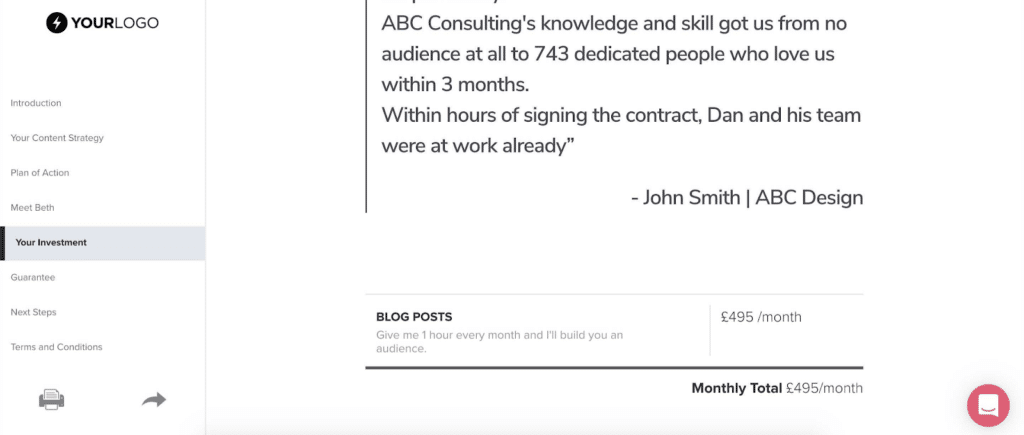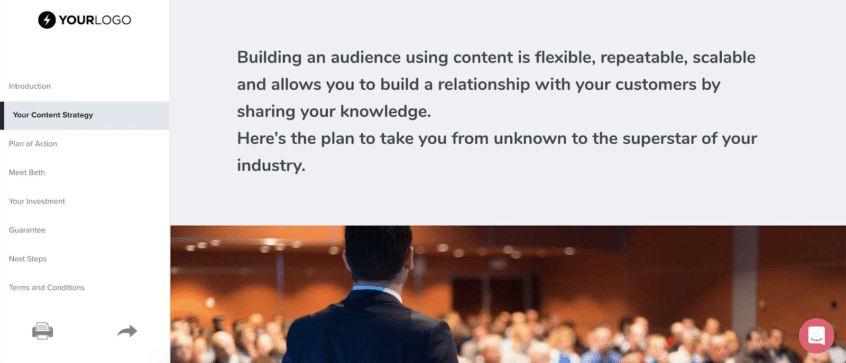Guest post by: Olga Mykhoparkina, CMO at Better Proposals
- Start with the introduction
- The detailed specification
- The timelines
- The pricing
- The guarantee
- The proof
- The next steps
- The terms and conditions
One of the hardest parts of winning new clients for your content marketing business is writing and sending business proposals. As tedious as they are, proposals are crucial to convincing your client that you’re an experienced content marketer (or agency) that can bring them results with your writing and strategy. And even though you are a skilled writer, writing business proposals is something completely different from your blogs, case studies and other types of content. Instead of writing proposals from scratch, you should use a content marketing template to finish your proposals faster and make them convert better.
Here is how to write a content marketing proposal template that helps you win more business in less time.
1. Start with the introduction
In this part of the template, make sure to talk about the client rather than what you can do for them as a content marketer/agency. Talk about their true pain point and how you can help them resolve it. For most clients, this means more traffic/better keyword rankings/better conversions/having thought leadership content on their blogs or something else. Your introduction should get them hooked to move on to the rest of the proposal.
The effectiveness of the introduction will greatly depend on what happened before it. If you learned enough about the client from your discovery sessions and meetings, the introduction should be a walk in the park. Start from the client’s needs and address them directly. For example:
“We know that you’re having problems with high bounce rates, short average duration session and low conversions. Carefully crafted content based on your ideal target audience is just what you need to solve all of your problems at once. And we can create that content for you.”
One tip that we have for great introductions is to write down the expressions that the client uses in their kick-off meetings and use them when writing the introduction. In essence, talk back to them, using their own words – it works really well.
2. The detailed specification
This is the true meat of the content marketing proposal. Here you will cover technical details such as what you will write, how many words/sections/pages it will have, how many writers are doing the work and at what schedule you will deliver their content. The more details you cover here, the fewer questions the clients will ask later on.

For example, a detailed specification may include the following:
- How many pieces of content you will create weekly/monthly
- What kind of content is included in the offer (blogs, accompanying social media blurbs, LinkedIn posts, etc.)
- Whether the content is SEO optimized or not
- Who sources the images for the content
- Who uploads and posts the content on your website
- How many writers will be taking care of the work
- Etc.
A well-written detailed specification section will save you lots of time and work later on. If things go south, this is the section you can refer to because you’ll have everything in writing.
3. The timelines
Something as simple as a timeline is one of the most commonly forgotten elements in content marketing proposals. State when you can deliver the work and be as specific as possible.
For example, you can state at which intervals you plan to deliver your content – weekly, bi-weekly, monthly, etc. Moreover, you can write out a full outline of what you’re going to do: content strategy in week one, topic outlines in week two, the first piece of content delivered in week three and onwards, etc. Just like the previous section, remember that you can go back to this section later if there are any disagreements between you and the client.
4. The pricing
This is the second most read section in any content marketing proposal. Make sure to make your pricing super clear and don’t give the client too many options, i.e. upsells. Your main aim with the template is to get them to say yes to your proposal and even our own research showed that having just a single offer and pricing works better for getting your proposal signed. If you use proposal software, you can implement different pricing methods in your template with ease.

When it comes to pricing in your templates, there is just one, major rule: keep it stupid simple. One offer, one price. The moment you add upsells or cross-sells, you’re hurting your chances of getting the client’s signature. The simpler your pricing structure, the better you will do. As for general pricing tips, it is best to stick to pricing per project instead of charging per word or hour.
5. The guarantee
As a content marketer, you cannot guarantee that a piece of content will rank a certain position. However, you can guarantee that you will deliver your work in the given deadline and according to the client’s instructions. You can give the typical money-back guarantee or something riskier, such as writing additional content for the same price. In any case, you need this section.
You can go wild here and come up with something unique. For example, writing a case study in case you miss a deadline for your article. Alternatively, you could write an extra 100 words for each day that you’re late with an assigned project. Just having a guarantee is good enough, but think of something that will make the client sign even more quickly. You can personalize your guarantee for each client, but having just one in your proposal template is good enough.
6. The proof
It’s crucial to have a section where you show social proof. This is where you share a mini case study about a previous client where you did marvelous work, preferably with results you were able to achieve. This part of the template is more generic because ideally, every proposal you send should have a different proof section that closely matches the client receiving the proposal.
The trick with the proof section is to make it as personalized as possible. Ideally, you’ve already had a similar client in a similar industry before and you can show the results of your content marketing campaigns. Having a documented success story can go a long way in showing your client that you’re the right content marketer/agency to hire.
If you’re wondering what to include in your proof section, you can find inspiration in this Content Marketing and Distribution survey summary report. Alternatively, take a look at Building Thought Leadership with Content. The great thing is, there are probably several types of clients that you work with and you can create a proof section for each type of client and just swap them out.
7. The next steps
In this part of the content marketing proposal, you tell the client the exact steps they need to take to kick off work with you after reading the proposal. It can be reused for all of your proposals and it’s necessary because you want to give crystal clear instructions.
Don’t reinvent the wheel – this section needs to be really straightforward. You can just write a few steps that the client should follow if they want to get started with working with you. For example:
- Sign the proposal
- Pay 50% of the agreed sum directly from the proposal
- We schedule a kick-off call with you
- We start working on your content
The purpose of this part of the proposal template is to give the client brief instructions and set expectations for what happens next.
8. The terms and conditions
You can’t get a professional contract for every client you book, but you can get a T&C section that will protect both you and the client and make them feel safe about signing your proposal. You can also reuse this section as much as you want.
There are lots of terms and conditions generators online and you can grab a template instead of consulting a lawyer. However, if you intend to send a lot of content marketing proposals and you want a robust T&C section that protects everyone involved, it’s a good idea to consult a legal professional.
Conclusion
The ideal content marketing proposal template is based on your most successful proposals. It takes more time to create a template that works, but once you have it, the job of writing and sending proposals will be that much easier and more fruitful. Once you have the right content marketing proposal template, you will save significant time and you will be able to make more money in the process.
Guest post by: Olga Mykhoparkina, CMO at Better Proposals

